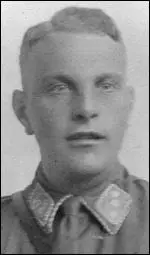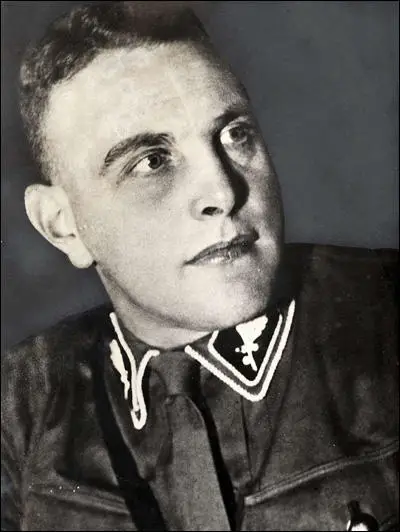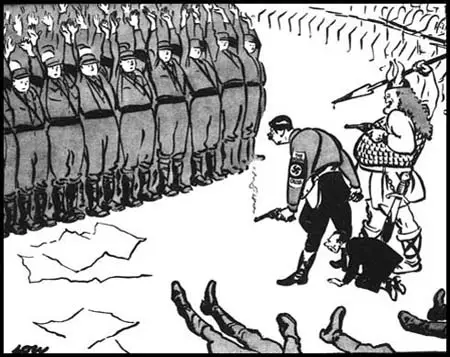Edmund Heines

Edmund Heines was born in Munich on 21st July, 1897. He served as a junior officer in the First World War. (1)
After the war former senior officers in the German Army began raising private armies called Freikorps. These were used to defend the German borders against the possibility of invasion from the Red Army. Edmund Heines joined the Freikorps in Munich. (2)
Heines took part in the fighting against left-wing socialists who were in control in Bavaria, where Kurt Eisner, the leader of the the Independent Socialist Party, had formed a coalition government with the Social Democratic Party. Eisner was assassinated by Anton Graf von Arco auf Valley on 21st February, 1919. It is claimed that before he killed Eisner he said: "Eisner is a Bolshevist, a Jew; he isn't German, he doesn't feel German, he subverts all patriotic thoughts and feelings. He is a traitor to this land." (3)
Friedrich Ebert, the president of Germany, eventually arranged for 30,000 Freikorps, under the command of General Burghard von Oven, to take Munich. During this period Heines got to know Ernst Röhm, who served under Colonel Franz Epp, during the operation. They entered the city on 1st May 1919 and over the next two days the Freikorps easily defeated the Red Guards. Heines eventually became adjutant to Gerhard Rossbach. (4)
Edmund Heines and the Nazi Party
Edmund Heines joined the Nazi Party and became head of the Sturmabteilung (SA) in Munich and became a close associate with Röhm. (5) William L. Shirer, the author of The Rise and Fall of Nazi Germany (1959) argued that the group was " a motley mob of brawlers" and that Heines and Röhm "were notorious homosexual perverts" and "these two and dozens of others quarreled and feuded as only men of unnatural sexual inclinations, with their peculiar jealousies, can". (6)
On 6th May, 1925, Adolf Hitler controversially appointed Edmund Heines to deal with "all matters relating to the youth movement". This concerned several senior figures in the Hitler Youth movement. (7) Heines was described as having "a girlish face on the body of a truck driver" developed a reputation for violence and sexual perversion and in May 1927 Hitler expelled him from the Nazi Party for having "loose morals" but others claimed it was because he was overheard calling the Führer a "dishrag". Röhm protested the decision and he was allowed back into the party. (8)
In 1929 Edmund Heines was sentenced to five years' imprisonment for being involved in "Fehme" murders. (9) It was claimed that groups of SA men held so-called Fehme courts where they condemned left-wing political opponents to death. They would then select one from their group to carry out the sentence. Heines was released soon afterwards as part of a general amnesty. (10)
Edmund Heines continued to organize attacks against members of the German Communist Party (KPD) and the Social Democratic Party (SDP). On the night of 9-10th August 1932, Heines organized a series of attacks in the city of Görlitz. Squads of SA men shot at individuals and hurled grenades at the homes of their political opponents. "Under police questioning, SA man and gardener Helmut Engmann signed a confession implicating the whole Silesian SA command structure". (11)
Adolf Hitler and the SA
After the election of Adolf Hitler in 1933 Heines was appointed SA-Opbergruppenführer assigned to Silesia and was made Chief Commissioner of the Police in Breslau. (12) He also served as deputy to Ernst Röhm, the head of the Sturmabteilung (SA). Industrialists such as Albert Voegler, Gustav Krupp, Alfried Krupp, Fritz Thyssen and Emile Kirdorf, who had provided the funds for the Nazi victory, were unhappy with Röhm's socialistic views on the economy and his claims that the real revolution had still to take place. Walther Funk reported that Hjalmar Schacht and his friends in big business were worried that the Nazis might begin "radical economic experiments". (13)

In June 1933, the National Liberal MP, Robert Bernays went to Germany and had a meeting with Edmund Heines, Although he admitted that Heines "had, so far as the atrocities were concerned, the most evil and extraordinary reputation in all Germany" Bernays found him an attractive man. "Heines appeared a charming fellow - young, about thirty-five years of age, fair hair, blue eyes, smiling, boyish... he was such a fine figure of a man that it reminded me of an English staff officer, or the captain of a rugby fifteen who has just been made head boy... He was gloriously self-confident, so naively exultant in his new sense of power.... Heines had all the attributes that make for hero-worship... They (Nazi leaders) had homosexuality and sadism written all over them." (14)
Heines took Bernays to Breslau concentration camp that had been created to provide "protective custody" for Silesian Jews and members of the Communist Party (KPD) and Social Democrat Party (SDP). "This was a prison and the inmates were given backbreaking and nugatory tasks. One group was turning a marshy wasteland into municipal baths... Another was watering plants by the barbed wire in the shape of a swastika. When the visitors approached an inmate he would mechanically repeat the line that the work was hard but they were getting used to it and that they were well fed. If there were questions about a prisoner who had never been heard of again, the stock answer was trundled out: 'Shot while trying to escape'." (15)
Bernays was constantly aware of signs in Germany saying "Jews excluded". He also heard desperate tales of German Jews being forced to leave all their money and possessions behind when they fled. Bernays was shocked by Heines's insistence that Europe was threatened by a very formidable communist peril and his justification of the attack on the Jews on the grounds that "Jewish money was behind it all." (16) He later commented: "I cannot get out of my mind, even now, the expression of terror on the faces of so many with whom we talked." (17)
The Night of the Long Knives
General Werner von Blomberg, Hitler's minister of war, and Walther von Reichenau, chief liaison officer between the German Army and the Nazi Party, became increasingly concerned about the growing power of Ernst Röhm and the Sturmabteilung (SA). They feared that the SA was trying to absorb the regular army in the same way that the SS had taken over the political police. (18)
Heinrich Himmler and Karl Wolff went to visit Ernst Röhm at the SA headquarters in April, 1934. According to Wolff he "implored Röhm to dissociate himself from his evil companions, whose prodigal life, alcoholic excesses, vandalism and homosexual cliques were bringing the whole movement into disrepute". He then said with moist eyes, "do not inflict me with the burden of having to get my people to act against you". Röhm, also with tears in his eyes, thanked his old comrade for giving him this warning. (19)
On 4th June, 1934, Hitler held a five-hour meeting with Röhm. Afterwards he told his friends that he was convinced that he could rely on Hitler to take his side against "the gentlemen with uniforms and monocles". (20) Louis L. Snyder argues that Hitler had in fact decided to give his support to Röhm's enemies: "Hitler later alleged that his trusted friend Röhm had entered a conspiracy to take over political power. The Führer was told, possibly by one of Röhm's jealous colleagues, that Röhm intended to use the SA to bring a socialist state into existence... Hitler came to his final decision to eliminate the socialist element in the party." (21)
Heinrich Himmler and Reinhard Heydrich worked on drawing up a list of people who were to be eliminated. It was known as the "Reich List of Unwanted Persons". (22) The list included Ernst Röhm, Edmund Heines, Gregor Strasser, Kurt von Schleicher, Hitler's predecessor as chancellor, Gustav von Kahr, who crushed the Beer Hall Putsch in 1923, and Erich Klausener, the President of the Catholic Action movement, who had been making speeches against Hitler. On 24th June, 1934, Klausener had organised a meeting held at Hoppegarten racecourse, where he spoke out against political oppression in front of an audience of 60,000. (23)
On the evening of 28th June, 1934, Hitler telephoned Röhm to convene a conference of the SA leadership at Hanselbauer Hotel in Bad Wiesse, two days later. "The call served the double purpose of gathering the SA chiefs in one out-of-the-way spot, and reassuring Röhm that, despite the rumours flying about, their mutual compact was safe. No doubt Röhm expected the discussion to centre on the radical change of government in his favour promised for the autumn." (24)
At around 6.30 in the morning of 30th June, Hitler arrived at the hotel in a fleet of cars full of armed Schutzstaffel (SS) men. (25) Erich Kempka, Hitler's chauffeur, witnessed what happened: "Hitler entered Röhm's bedroom alone with a whip in his hand. Behind him were two detectives with pistols at the ready. He spat out the words; Röhm, you are under arrest. Röhm's doctor comes out of a room and to our surprise he has his wife with him. I hear Lutze putting in a good word for him with Hitler. Then Hitler walks up to him, greets him, shakes hand with his wife and asks them to leave the hotel, it isn't a pleasant place for them to stay in, that day. Now the bus arrives. Quickly, the SA leaders are collected from the laundry room and walk past Röhm under police guard. Röhm looks up from his coffee sadly and waves to them in a melancholy way. At last Röhm too is led from the hotel. He walks past Hitler with his head bowed, completely apathetic." (26)
Edmund Heines was found in bed with his chauffeur. (27) According to eyewitnesses, Hitler ordered the "ruthless extermination of this pestilential tumour." Heines and his young companion were dragged from the room and shot and became the first victims of the Night of the Long Knives. (28)

It is not known how many people were murdered between 30th June and 2nd July, when Hitler called off the killings. Adolf Hitler admitted to 76, but the real number is probably nearer 200 or 250. "Bodies were found in fields and woods for weeks afterwards and files of petitions from relatives of the missing remained active for months. What seems certain is that less than half were SA officers." (29)
Primary Sources
(1) William L. Shirer, The Rise and Fall of Nazi Germany (1959)
After considerable difficulties the S.A. was reorganized into an armed band of several thousand men to protect Nazi meetings, to break up the meetings of others and to generally terrorize those who opposed Hitler. Some of its leaders also hoped to see the S.A. supplant the Regular Army when Hitler came to power...
The brown-shirted S.A. never became much more than a motley mob of brawlers. Many of its top leaders, beginning with its chief, Röhm, were notorious homosexual perverts. Lieutenant Edmund Heines, who led the Munich S.A., was not only a homosexual but a convicted murderer. These two and dozens of others quarreled and feuded as only men of unnatural sexual inclinations, with their peculiar jealousies, can.
(2) Otis C. Mitchell, Hitler's Stormtroopers and the Attack on the German Republic (2013)
From his headquarters in Breslau, Edmund Heines sent out instructions to subordinate-officers to organize clandestine terror campaigns. For example, on the night of 9-10 August 1932, in the city of Gorlitz, midway between Dresden and Breslau, squads of SA men hurled grenades at the homes of Reichbanner leaders or SPD offices. They shot at individuals, threw rocks through the windows of Social Democratic installations, etc... Under police questioning, SA man and gardener Helmut Engmann signed a confession implicating the whole Silesian SA command structure.
(3) After the war Edward von Kleist of the German Army recalled the events of June, 1934.
Round about 24 June 1934, I as the army commander in Silesia was warned by the Chief of the General Staff (Ludwig Beck) that an attack by the SA on the German Army was imminent and that I should unobtrusively keep my troops on the alert. During the tense days following, I received a flood of reports and information which gave a picture of feverish preparations on the part of the SA. In this situation, I considered that bloodshed could only be avoided by a man-to-man talk.
On the afternoon of 28 June, therefore, I asked SA Commander Heines to come and see me; I told him to his face that I knew of his preparations and I gave him a warning. He replied that he knew all about my measures and had thought that they were preparations for an attack on the SA. He had only put the SA on alert in order to resist an attack. He gave his word as an officer and SA leader that he had not planned or prepared any surprise attack upon the Army.
During the night of 28-29 June, Heines rang me up again. He had just learned that the Army throughout the Reich, was on the alert for an SA putsch. I said to him that "I have the impression that we - Army and SA - are being egged on against each other by a third party." By that I mean Himmler.
Student Activities
Adolf Hitler's Early Life (Answer Commentary)
The Hitler Youth (Answer Commentary)
German League of Girls (Answer Commentary)
The Political Development of Sophie Scholl (Answer Commentary)
The White Rose Anti-Nazi Group (Answer Commentary)
Kristallnacht (Answer Commentary)
Heinrich Himmler and the SS (Answer Commentary)
Trade Unions in Nazi Germany (Answer Commentary)
Adolf Hitler v John Heartfield (Answer Commentary)
Hitler's Volkswagen (The People's Car) (Answer Commentary)
Women in Nazi Germany (Answer Commentary)
